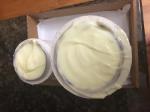Overheated Soap Balls
by Ashlee O.
(Bothell, WA)
I was looking over your decorative ideas for soap making and, because I had a batch that didn't turn out quite like I had hoped, I was inspired and grated the soap making a bunch of small soap balls.
When I made my soap base - my own concoction based on your goat milk soap recipe but tweaked a little and run through the soap calculator - I put the soap balls in as I poured my lightly traced soap.
The soap didn't turn out at all and I'm not quite sure where I went wrong, although it was my first attempt at the room temp method and I think I may have over insulated the soap given that it had the goats milk in it.
My main question though has to do with the soap balls. They seemed to kind of fizz or melt a little.
The soap base was a maroon-rose color thanks to some rose clay I added at trace and the soap balls were white.
When I got the soap out of the mold, there was a lot of white along the bottom edges of the soap and the balls looked like they had exploded a little, not the nice neat little balls I see in the pictures.
Could this just be because of whatever caused my soap to be mushy in the first place or is there some trick to adding soap bits to new soap?
Thanks for any help! This may be just a conundrum that I'll have to fiddle with, but maybe you can see an easy fix?
(I love your page, by the way. It has been the most helpful and informative by far.)
Answer:
Sorry to hear about your soap misshap!
There isn't any trick to adding soap balls or bits to traced soap batter. You simply put them in and stir.
For bits larger than shreds, I suggest a medium to thickly traced soap so that the balls do not sink to the bottom.
I think the problem must be due to whatever went wrong with the soap base. The soap would have had to get quite hot to 'explode' the soap balls. Quite possible though.
Overheated soap seems to take on a life of its own resulting in bizarre reactions like 'alien brains' (strange brain like patterns on the top of the soap), heaving and splitting of the soap (large mountainous top with a long crack along surface), and the cavernous center (cave like interior of soap that may have some liquid in it) to name a few.
It is important to watch any milk soap during the insulation period. Once it reaches a full gel, you need to remove any insulation you have placed on the mold to prevent the soap from overheating.
Cathy

